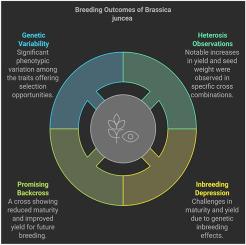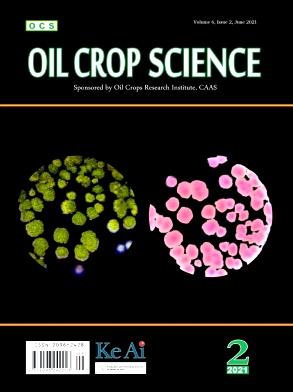基于产量和产量贡献性状的芥菜F2居群杂种优势及近交抑制评价
Q3 Agricultural and Biological Sciences
引用次数: 0
摘要
印度芥菜被认为是一种适应性强、经济上重要的油籽作物。然而,由于能够胜过其他rabi作物的短期高产品种有限,其潜力仍未得到开发。考虑到这一概念,我们在Sher-e-Bangla农业大学采用随机完全区组设计,评估了来自7个不同芥菜亲本的21个F2和6个BC1F1群体。根据主要农艺性状,对早熟高产群体的遗传组成、杂种优势、近交抑制和基因作用进行了研究。杂种优势比例表现在不同的杂交组合中,包括P4 × P6(单株产量91.45%)和P5 × P6(千粒重28.52%),是提高产量和管理负近交效应的有希望的候选组合。相反,在近交性状(如成熟期和产量)中,特别是在杂交组合P1 × P2(6.29%)和P3 × P5(21.74%)中,发现了显著的近交抑制,这强调了在育种计划中需要仔细选择以减轻这些影响。方差分析表明,加性和非加性遗传互作对感兴趣性状的遗传模式起关键作用。6个回交中,1个有希望的系为(P5 × P6) × P5,早熟(107.00 DAS),籽粒产量提高(12.47 g)。这种组合表现出通过保持成熟度指数和加速产量来提高适应性和生产力的潜力。单株千粒重和单株产量表现出较高的广义遗传力和狭义遗传力。籽粒产量与籽粒性状之间存在正相关关系,为选育提供了可能的途径。综上所述,这些发现有助于进一步了解芥菜杂种优势和近交抑制的遗传机制,为培育具有优化农艺性状的优良品种提供依据和有效策略。本文章由计算机程序翻译,如有差异,请以英文原文为准。

Evaluation of heterotic effects and inbreeding depression of F2 populations of Brassica juncea based on yield and yield-contributing traits
Indian mustard is recognized as a resilient and economically important oilseed crop. However, its potential remains untapped due to the limited availability of short-duration, high-yielding varieties capable of outcompeting other rabi crops. Considering this notion, we have evaluated twenty-one F2 and six BC1F1 populations derived from seven diversified parents of Brassica juncea following a Randomized Complete Block Design at Sher-e-Bangla Agricultural University. Based on key agronomic traits, the genetic components, heterosis, inbreeding depression, and gene action were studied to select early maturing and high-yielding populations. The percentage of heterosis was manifested in various cross-combinations, including P4 × P6 (91.45% for yield per plant) and P5 × P6 (28.52% for thousand seed weight), emerging as promising candidates for increasing productivity while managing negative inbreeding effects. Conversely, significant inbreeding depression was noted in traits like days to siliquae maturity and yield, particularly in crosses, P1 × P2 (6.29%) and P3 × P5 (21.74%), underscoring the need for careful selection in breeding programs to mitigate these effects. Variance analysis indicated that both additive and non-additive genetic interactions play a pivotal role in the inheritance patterns of the traits of interest. Among the six backcrosses, one promising line was (P5 × P6) × P5, demonstrating early maturity (107.00 DAS) with improved seed yield (12.47 g). This combination exhibited the potential for enhancing the adaptability and productivity by maintaining the maturity index and accelerating yield. Furthermore, significant phenotypic variation across yield-contributing traits was notable, whereas thousand seed weight and yield per plant showed high broad-sense and narrow-sense of heritability. Besides, positive correlations between seed yield and its attributing traits were noted, suggesting potential avenues for selection breeding. Collectively, the obtained findings enhance the understanding of genetic mechanisms underlying heterosis and inbreeding depression in B. juncea, providing insights and effective strategies for developing superior cultivars with optimized agronomic traits.
求助全文
通过发布文献求助,成功后即可免费获取论文全文。
去求助
来源期刊

Oil Crop Science
Food Science, Plant Science, Agronomy and Crop Science
CiteScore
3.40
自引率
0.00%
发文量
20
审稿时长
74 days
 求助内容:
求助内容: 应助结果提醒方式:
应助结果提醒方式:


